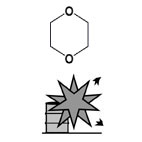| Case Name |
Explosion during charging operation of raw material powder into a reactor containing dioxane |
| Pictograph |

|
| Date |
April 16, 1997 |
| Place |
Tatsuno, Hyogo, Japan |
| Location |
Chemical factory |
| Overview |
At an epoxy resin plant, an explosion occurred in a reactor during charging raw materials. In the reactor, dissolution and addition of raw materials were executed sequentially. When raw material powder was charged from a opened manhole, static electricity was discharged, and dioxane vapor in the reactor ignited and exploded. The cause was as follows. Static electricity generated by friction between particles of powder was charged into a bag used for charging. As the manhole of the reactor was opened and work was done after argon substitution, a combustible mixture was generated. |
| Incident |
An explosion occurred at a reactor of an epoxy resin plant while charging raw material. Raw material dioxane had already been charged in the reactor. Additional raw-material charging and dissolution work were carrying out sequentially. During charging raw material powder through a manhole, an explosion occurred in the reactor. One operator died. |
| Processing |
Manufacture |
| Individual Process |
Charge and Feed |
| Process Flow |
Fig2.Unit process flow
|
| Substance |
Dioxane, Fig3 |
| Sorbit, Fig4 |
| Sodium hypophosphite, Fig5 |
| Type of Accident |
Explosion |
| Sequence |
09:55 on April 16th, 1997. Charging of raw material started. First, dioxane was charged into the reactor from drum cans. The gas in the reactor was substituted with argon gas as a countermeasure against static electricity.
15:10. During agitating, sorbitol contained in a flexible container was charged through the open manhole.
16:15. Then, an explosion occurred during charging a coloring inhibitor (sodium hypophosphite). One operator caught a blast and died. The roof was damaged.
The plant was stopped immediately. 35 self-fire-fighters turned out and fire extinguishing activities were carried out.
16:19. The public fire department was called out for help. Three fire engines and 21 fire fighters turned out.
Flexible container: A big bag made of cloth or synthetic fibers. The bag has a mouth at the top part for filling. A discharge mouth is prepared at the bottom part of the bag. It is used for storing and moving pellets or powder. In many cases, its capacity is about 0.5-1ton. |
| Cause |
As the manhole opening work was done after argon substitution, a combustible mixture was generated.
The coloring inhibitor was put into an empty bag for sorbitol (an inner bag made of polyethylene) and charged into the reactor.
The operators charged it by wearing latex gloves. Therefore, static electricity was discharged, and the combustible mixture of dioxane-air in the reactor ignited and exploded.
Polyethylene is a non-conductive material. |
| Response |
Injured workers were rescued.
An emergency shutdown of apparatus in operation. |
| Countermeasures |
A change of charge order of raw materials.
A revision of a work manual.
Wearing antistatic work clothes and humidification of the workplace.
Restriction of flow velocity of solvents in piping.
Providing workers with safety education and ensuring thorough management. |
| Knowledge Comment |
As static electricity is generated on charging raw material powder in a bag, the bag needs to have conductivity. Furthermore, antistatic measures should be taken, such as being earthed etc.
Gas substitution in a vessel becomes meaningless if air inflow is allowed.
A combustible mixture is generated in the adjacent area when the temperature of a flammable liquid is higher than its flash point. Therefore, it must be intercepted from air or must be fully ventilated. |
| Background |
Lack of knowledge of safety was the biggest factor. Measures for static electricity were not taken, for instance, using an empty bag made of polyethylene and treating with wearing latex gloves.
Although the gas inside the reactor was substituted with argon, the work was done with the manhole open. |
| Reason for Adding to DB |
Example of explosion caused due to reckless operation without consideration of safety |
| Scenario |
| Primary Scenario
|
Poor Value Perception, Poor Safety Awareness, Inadequate Risk Recognition, Organizational Problems, Poor Management, Slackness of Management, Ignorance, Insufficient Knowledge, Insuficient Study and Experience, Planning and Design, Poor Planning, Poor Design, Malicious Act, Rule Violation, Safety Rule Violation, Secondary Damage, External Damage, Explosion, Bodily Harm, Death
|
|
| Sources |
Fire and Disaster Management Agency, Dangerous material manufacturer explosion, Accident cases of dangerous material. 1997, pp.92-93.
The Res. Inst. of Industrial Safety material (closed).
|
| Number of Deaths |
1 |
| Physical Damage |
Only the second floor of the factory was damaged. A roof slate above a manhole broke. Slight deformation of a building.
Damage to a rupture disk, a mechanical seal, and a flexible hose. |
| Financial Cost |
¥ 6 million. (Fire and Disaster Management Agency). |
| Multimedia Files |
Fig3.Chemical formula
|
|
Fig4.Chemical formula
|
|
Fig5.Chemical formula
|
| Field |
Chemicals and Plants
|
| Author |
ITAGAKI, Haruhiko (Japan National Institute of Occupational Safety and Health)
TAMURA, Masamitsu (Center for Risk Management and Safety Sciences, Yokohama National University)
|
|